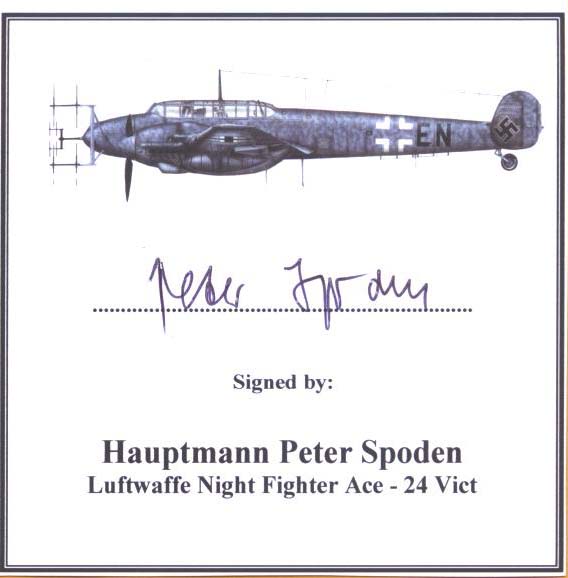
|
~SOLD~SPODEN Peter
Pleased to offer some unique items from a friend of mine who is lucky enough to work with many of the veterans on behalf of military artists, book publishers and documentary makers.Glossy book plate / card with biographical details
SPODEN Peter
Hauptmann Peter Spoden Luftwaffe Night Fighter Ace with 24 victories
Peter Spoden was born on 8 November 1921 at Borken near Münster. He completed his education in 1940 and began work on the railways despite a long held dream to become a pilot. Spoden learned to fly gliders with the Hitler Youth. He finally joined the Luftwaffe in October. He began his flying training at the Luftkriegsschule 4 at Fürstenfeldbruck. After gaining his Pilot’s Badge and A/B flying certificate, Spoden attended Flugzeugführerschule C 17 at Pütnitz where he trained to fly multi-engine types. He was promoted to the rank of Leutnant on 1 February 1942. On 1 September, Spoden attended the Blindflugschule at Copenhagen for instrument flight training before progressing to the Nachtjagdschule at Kitzingen for operational training. On 1 June 1943, Spoden was transferred to NJG 5. Leutnant Spoden was assigned to 6./NJG 5 based at Parchim. He claimed his first victory on the night of 17/18 August, when he intercepted a RAF formation attacking the German research facilities at Peenemünde. Spoden was able to shoot down a Lancaster four-engine bomber between Hanshagen and Greifswald. On the night of 22/23 August, he was ordered to take off towards Berlin to intercept a force of 727 RAF aircraft targeting the capital city. Spoden shot down a RAF Halifax four-engine bomber, to record his second victory, before engaging a RAF Stirling four-engine bomber. While he was able to shoot down the Stirling, the rear-gunner was able to score hits on Spoden’s Bf 110 night-fighter, wounding him in the left leg, shattering his femur and setting his aircraft on fire. He baled out of his stricken machine but contacted the tail unit pinning him to the elevator. Fortunately, he was thrown clear and descended to land in the garden of a residence in the suburbs of Berlin. Spoden would spend three months recuperating from his wounds, returning to active duty in November. Spoden joined 5./NJG 5 on his return to active duty. By the end of 1943, he had raised his victory total to four. In January 1944, Spoden claimed five victories, including two in a night on 14/15 January and 27/28 January, to raise his victory total to nine. During early 1944, He also participated in daylight missions intercepting USAAF bomber raids. On 6 March, Spoden participated in the interception of the first USAAF daylight raid on Berlin. He engaged the formation north of Rostock but his Bf 110 was hit in the port wing and engine. Managing to nurse his damaged aircraft back to his base at Parchim, Spoden was forced to carry out a belly landing because his undercarriage had also been damaged in the incident. On the night of 26/27 March, he was shot up again by an unknown assailant in the Stettin area. Spoden force-landed his damaged Bf 110, out of fuel, at Kornwestheim, near Stuttgart. He and his crewmen all received injuries in the incident resulting in several weeks in hospital. Shortly after returning to combat duty following his misfortune in late March 1944, Spoden was assigned to the Stabsstaffel of III./NJG 6 and relocated to Steinamanger in Hungary. The transfer also resulted in a change of equipment with the Gruppe re-equipping with the Ju 88 twin-engine night-fighter. Spoden recorded one victory with the unit when he shot down a RAF Wellington twin-engine bomber near Neunkirchen that was targeting the oifields at Pardubice for his 10th victory. In August 1944, Spoden was transferred to the Stabsstaffel of II./NJG 6 based at Swäbisch Hall. On 5 October, he was awarded the Ehrenpokal. On 1 December, Spoden was promoted to the rank of Oberleutnant. By the end of 1944, he had raised his victory total to 18, including three Lancasters shot down near Heilbronn of a force attacking the railway yards (15-17). By late December, Oberleutnant Spoden was appointed Staffelkapitän of 6./NJG 6. On the night of 26/27 December, he was seeking Allied gliders supplying men and equipment to encircled troops at Bastogne when his aircraft was hit by German flak. The port engine immediately caught fire and he was forced to belly-land his aircraft near Stradtkyll. Knocked unconscious when his head struck the gunsight, Spoden was pulled from the blazing wreckage by his crewmen. On 21 February 1945, Spoden recorded his 20th victory when he shot down Lancaster near Worms. In late February, he was awarded the Deutsches Kreuz in Gold for 22 victories. Spoden recorded his last two victories on the night of 7/8 March, whne he shot down two Lancasters near Dessau. However, his Ju 88 received hits from return fire resulting in the feathering of one engine. Losing altitude steadily, Spoden ordered the evacuation of the aircraft near Crailsheim. All four members of the crew safely baled out. On 19 March 1945, Spoden was appointed Gruppenkommandeur of I./NJG 6. On 29 April, the remnants of NJG 6 surrendered to American troops at Schleissheim
.
Peter Spoden was credited with 24 night victories, all but one were four-engine bombers.
Information from www.luftwaffe.cz
Card measures 3 ¾” x 4”
Price: $0.00
Please contact us before ordering to confirm availability and shipping costs.
Buy now with your credit card
other ways to buy
|


